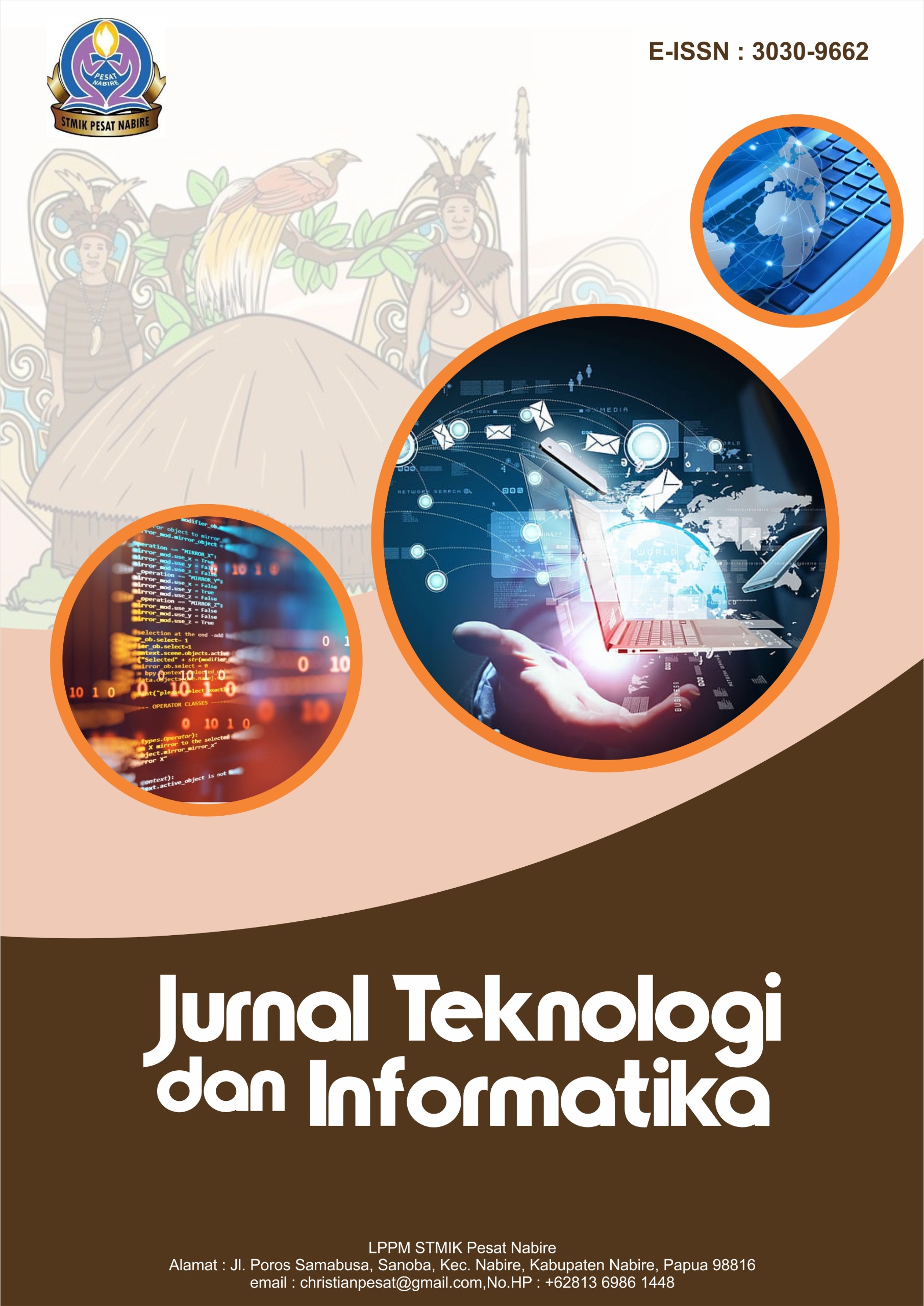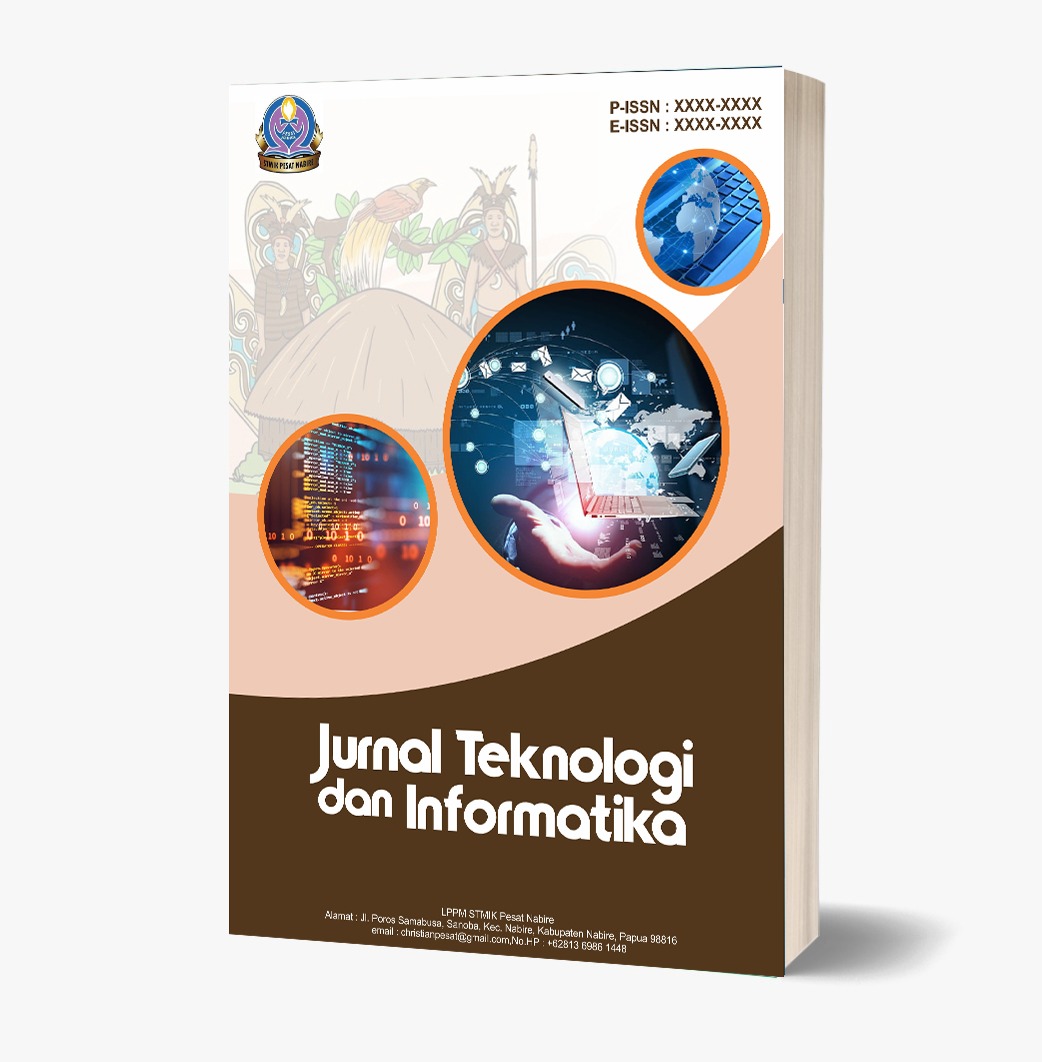Evaluasi Penggunaan Sistem Informasi Akademik Berbasis Web [eCampuz]: Pendekatan Mixed Methods terhadap Kepuasan Pengguna
DOI:
https://doi.org/10.70539/jti.v3i1.53Keywords:
eCampuz, Kepuasan Pengguna, Sistem Informasi Akademik, Mixed MethodAbstract
STMIK Pesat Nabire is a private university in Papua Tengah that uses a web-based academic information system called eCampuz. User satisfaction evaluation plays a crucial role in improving the quality of academic services at an institution. The purpose of this study is to determine the extent of user satisfaction with eCampuz at STMIK Pesat Nabire, identify the factors influencing such satisfaction, and pinpoint the aspects of eCampuz that need to be improved and developed to enhance user satisfaction. This study employs a mixed-methods approach with an explanatory sequential design. The results indicate that the majority of users are satisfied with five key aspects of eCampuz, 80% for System Quality, 80% for Features and Functions, 87% for Security and Privacy, 80% for Usability, and 80% for User Satisfaction. Several shortcomings and challenges were also identified, such as the absence of automatic notifications when instructors post materials, assignments, and attendance records, the lack of date markers on materials posted by instructors, making it difficult for students to distinguish between new and old materials, errors and slow loading times in attendance records, limited file upload capacity, and the inability to accept certain file formats. Regular evaluations of user satisfaction are needed to further improve the system and ensure that user satisfaction is met.
References
[1] B. S. Damanik, R. A. Putri, and A. M. Harahap, “Implementasi Metode Webqual 4.0 Dalam Mengevaluasi Sistem Informasi Akademik Uin Sumatera Utara,” JTIK (Jurnal Teknik Informatika Kaputama), vol. 8, no. 1, pp. 15–23, 2024, doi: 10.59697/jtik.v8i1.489.
[2] R. Pebrianto, P. Maulina, S. N. Nugraha, and F. N. Cahya, “Analisis Kesuksesan Sistem Informasi Akademik Menggunakan Model Sukses Delone dan Mclean,” Bina Insani Ict Journal, vol. 10, no. 1, pp. 38–51, 2023, doi: 10.51211/biict.v10i1.2233.
[3] N. M. Maulida, S. E. Prastya, A. Hidayat, Mambang, and R. N. Pratama, “Evaluasi Kepuasan Pengguna Sistem Informasi Akademik (SIAKAD) Universitas Sari Mulia Banjarmasin Menggunakan Metode End User Computing Satisfaction (EUCS),” Jurnal Nasional Komputasi dan Teknologi Informasi (JNKTI), vol. 7, no. 5, pp. 1012–1020, 2024.
[4] N. Amalia, D. J. S. HS, and W. Hapsoro, “Analisa Pengaruh Kepuasan Pengguna Terhadap Kualitas Sistem Informasi Akademik dengan Metode EUCS (End User Computing Statisfaction),” IC-Tech, vol. 16, no. 1, pp. 16–21, 2021.
[5] N. Nafisah and M. H. Ujianti, “Perancangan Sistem Informasi Akademik Pengolahan Data Nilai Siswa Pada SD Negeri Mangunsaren 02 Berbasis Website,” JATI (Jurnal Mahasiswa Teknik Informatika), vol. 9, no. 1, pp. 138–144, 2025.
[6] M. R. Albhantany, A. K. Al Anshori, and J. H. S. Ringo, “Implementasi Sistem Informasi Akademik Berbasis Web (Studi Kasus di Universitas Tanri Abeng Jakarta),” Jurnal SISKOM-KB (Sistem Komputer dan Kecerdasan Buatan), vol. 6, no. 1, pp. 37–47, 2022, doi: 10.47970/siskom-kb.v6i1.325.
[7] O. Mandasari, D. Hidayati, and D. L. Damayanti, “Implementasi Sistem Informasi Manajemen Akademik Berbasis Teknologi Informasi Di Perguruan Tinggi Vokasi,” Jurnal Cahaya Mandalika, vol. 4, no. 1, pp. 273–281, 2023.
[8] M. Y. Arafat and Y. P. Pratama, “Sistem Informasi Akademik Berbasis Web Menggunakan Metode Pengembangan Sistem Extreme Programming,” Jurnak Informatika Universitas Pamulang, vol. 9, no. 4, pp. 173–178, 2024, doi: 10.32493/informatika.v9i4.46008.
[9] H. Budiman, A. Elanda, and M. Wahidin, “Analisis Kepuasan Mahasiswa Dalam Penggunaan Sistem Informasi Akademik (SIAKAD) Menggunakan End User Computing Satisfaction (Studi Kasus STMIK Rosma),” Dirgamaya: Jurnal Manajemen dan Sistem Informasi, vol. 2, no. 1, pp. 1–10, 2022, doi: 10.35969/dirgamaya.v2i1.256.
[10] A. L. Pondaag, M. R. Katili, and A. Zakaria, “Evaluasi Pengukuran Tingkat Kepuasan Pengguna Sistem Informasi Akademik (SIAKAD) Menggunakan Metode End User Computing Satisfaction (EUCS) di Universitas Gorontalo,” Jurnal of System and Information Technology, vol. 3, no. 2, pp. 1–10, 2023.
[11] R. Tanoga, L. Ahmad, and R. Akbar, “Analisis Tingkat Kepuasan Pengguna Aplikasi Competence Development Center (CDC) pada Lembaga Pendidikan Pengembangan Profesi Indonesia (LP3I) Menggunakan Metode End-User Computing Satisfaction (EUSC),” Jurnal Ilmu Komputer dan Teknologi Informasi, vol. 2, no. 1, pp. 45–60, 2025, doi: 10.35870/jikti.v2i1.1344.
[12] M. Nurhadi, M. L. Hamzah, T. K. Ahsyar, and M. Jazman, “Analisis Kepuasan Pengguna Sistem Informasi E-Campus Menggunakan Metode E-Servqual Dan Model Kano,” Building of Informatics, Technology and Science (BITS), vol. 4, no. 3, pp. 1401–1411, 2022, doi: 10.47065/bits.v4i3.2691.
[13] Hendrayadi, M. Kustati, and N. Sepriyanti, “Mixed Method Research,” Jurnal Review Pendidikan dan Pengajaran (JRPP), vol. 6, no. 4, pp. 2402–2410, 2023, [Online]. Available: https://journal.universitaspahlawan.ac.id/index.php/jrpp/article/view/21905/15436
[14] O. Cahyadi, P. Baihaqi, M. R. Firdaus, and E. Sulaeman, “Analisis terhadap Kualitas Sistem Informasi Akademik ( E-Campus ) dan Pengaruhnya terhadap Kepuasan Mahasiswa Fakultas Ekonomi Universitas Singaperbangsa Karawang dengan Pendekatan Metode Servqual,” Jurnal Pendidikan Tambusai, vol. 7, no. 3, pp. 29467–29472, 2023.
[15] A. S. Ariska and M. Rudi Sanjaya, “Analisis Tingkat Kepuasan Pengguna Aplikasi Sistem Informasi Akademik (Siakad) Berbasis Website Menggunakan Metode End-User Computing Satisfaction (EUCS),” Indonesian Journal of Computer Science, vol. 12, no. 6, pp. 4038–4052, 2023, doi: 10.33022/ijcs.v12i6.3583.
[16] M. Bilung, S. Maharani, and D. M. Khairina, “Analisis Kepuasan Pengguna Sistem Informasi Terpadu Layanan Program Studi (SIPLO) Menggunakan System Usability Scale (SUS),” Adopsi Teknologi dan Sistem Informasi (ATASI), vol. 2, no. 2, pp. 89–97, 2023, doi: 10.30872/atasi.v2i2.387.
[17] J. A. Habibullah, I. Norvaizi, and D. E. C. Dewi, “Implementasi Mixed Methods dalam Penelitian Pendidikan: Konsep dan Aplikasinya,” Peradaban Journal of Interdisciplinary Educational Research, vol. 3, no. 1, pp. 17–31, 2025, doi: 10.59001/ pjier.v3i1.245.
[18] F. H. Nasution, Risnita, M. S. Jailani, and R. Junaidi, “Kombinasi (Mixed-Methods) Dalam Praktis Penelitian Ilmiah,” Journal Genta Mulia, vol. 15, no. 2, pp. 251–256, 2024, [Online]. Available: https://ejournal.stkipbbm.ac.id/index.php/gm
[19] F. Masito, Y. Komalasari, N. Idyaningsih, S. Hamzah, and H. Winarto, “Pengukuran Tingkat Kepuasan Pelayanan Pusat Penelitian dan Pengabdian Kepada Masyarakat,” Airman: Jurnal Teknik dan Keselamatan Transportasi, vol. 5, no. 2, pp. 127–134, 2022, doi: 10.46509/ajtk.v5i2.288.
[20] S. Romdona, S. S. Junista, and A. Gunawan, “Teknik Pengumpulan Data: Observasi, Wawancara dan Kuesioner,” JISOSEPOL: Jurnal Ilmu Sosial Ekonomi dan Politik, vol. 3, no. 1, pp. 39–47, 2025.














